
Tetrahedron

Octahedron

Icosahedron

Great Icosahedron
Isogonal Deltahedra
This page contains an exploration of the possibilities for isogonal deltahedra, i.e. polyhedra which are face transitive and consist of equilateral triangular faces. A total of 33 isogonal deltahedra are presented, of which 10 are thought to be new discoveries.
Deltahedra from Uniform Polyhedra
Four isogonal deltahedra appear amongst the platonic and Kepler-Poinsot polyhedra
 Tetrahedron |
 Octahedron |
 Icosahedron |
 Great Icosahedron |
Deltahedra From Johnson Solids
Two further deltahedra appear amongst the Johnson Solids:
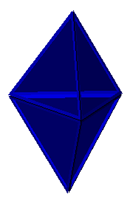 Triangular Bipyramid |
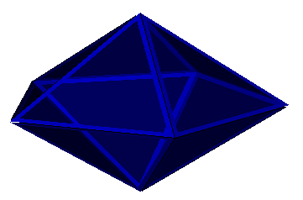 Pentagonal Bipyramid |
Extending these figures to consider re-entant polyhedra, the family of {n/d}-bipyramids consists of isogonal deltahedra within the range 2 < n/d < 6. As examples, see this {7/2}-bipyramid and {7/3}-bipyramid.
Deltahedra from Augmented Uniform Polyhedra
Each of the platonic and Kepler-Poinsot polyhedra can potentially be augmented or excavated with pyramids. A number of the figures are degenerate. Overall 12 isogonal deltahedra are formed.
| Tetrahedron | 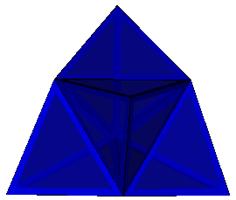 Augmented |
degenerate see Tetrahedron |
| Octahedron | 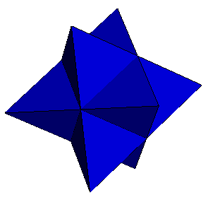 Augmented (Stellar Octangula) |
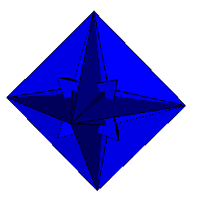 Excavated |
| Cube | 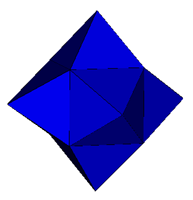 Augmented |
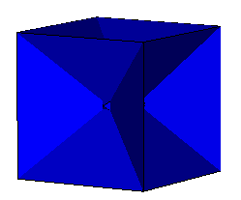 Excavated |
| Icosahedron | 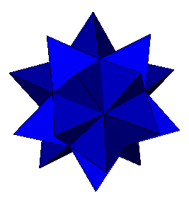 Augmented |
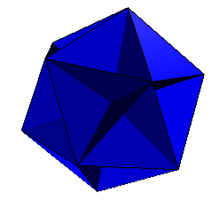 Excavated |
| Dodecahedron | 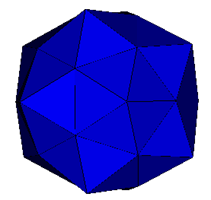 Augmented |
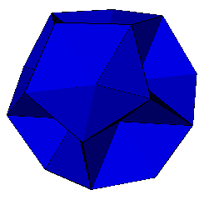 Excavated |
| Great Icosahedron | 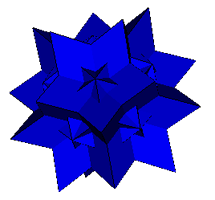 Augmented |
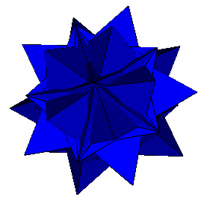 Excavated |
| Great Dodecahedron | degenerate see Icosahedron |
see Excavated Icosahedron |
| Small Stellated Dodecahedron | 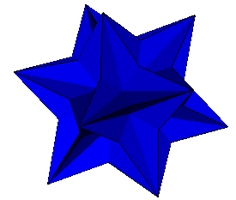 Augmented |
degenerate see Great Icosahedron |
| Great Stellated Dodecahedron | degenerate see Great Icosahedron |
see Excavated Icosahedron |
Deltahedra from Deformed Augmented Duals of Tetra-valent Semi-regular Polyhedra - and the M°bius Deltahedra
Apart from the cube, which is discussed above, there are four other rhombic polyhedra which have the property of being edge-transitive. These are all duals of tetra-valent semi-regular polyhedra. These can each be augmented or excavated with pyramids to form non-regular deltahedra. These can all then be deformed such that the faces become equilateral triangles. Face transitivity is retained in all cases. The 8 isogonal deltahedra formed in this fashion are listed below.
| Rhombic Dodecahedron | 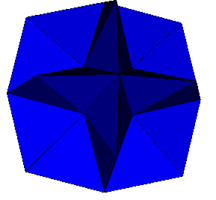 Augmented |
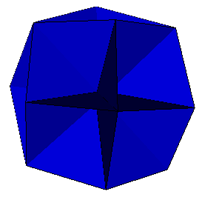 Excavated |
| Rhombic Triacontahedron | 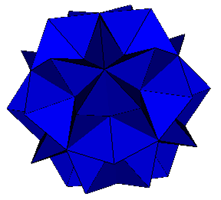 Augmented |
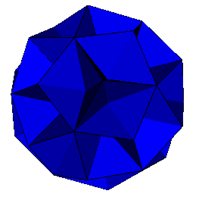 Excavated |
| Medial Rhombic Triacontahedron | 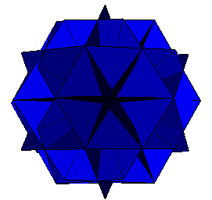 Augmented Vert |
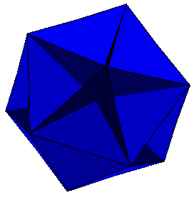 Excavated Vert |
| Great Rhombic Triacontahedron | 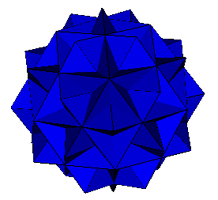 Augmented |
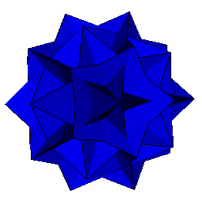 Excavated |
The text 'Vert' next to the models of the medial rhombic triacontahedron leads to VRML files with the vertices highlighted. Switching to frame mode and zooming into the centre of the polyhedra shows the configurations of the inner vertices.
There is a set of five isogonal deltahedral figures known as M°bius Deltahedra. Melinda Green discusses these figures at http://www.superliminal.com/geometry/deltahedra/deltahedra.htm. Four of these figures can be obtained by augmenting or excavating the rhombic dodecahedron and rhombic triacontahedron as above. The fifth is a 24 faced figure isomorphous to the augmented cube (image below), it is not derived from any rhombic figure. The remaining 4 deltahedra derived from the medial rhombic triacontahedron and great rhombic triacontahedron are thought to be new.
Deltahedra from Deformed Augmented Duals of Hexa-valent Semi-regular Polyhedra
The semi-regular ditrigonary polyhedra - with vertex figures of (m,n,m,n,m,n) - have duals which consist of hexagonal faces and are also edge transitive. The above process of augmentation/excavation and deltification can also be applied to these figures. Some of the resulting figures are degenerate. The 4 new deltahedra that result are included in the table below.
| Uniform Polyhedron | ||
| Ditrigonary
Dodecadodecahedron
(Dual) |
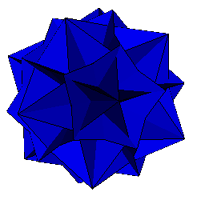 Augmented |
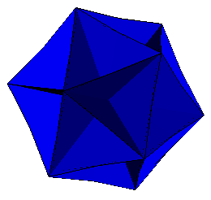 Excavated Vert |
| Small
Ditrigonary Icosidodecahedron
(Dual) |
Degenerate see Augmented Dodecahedron |
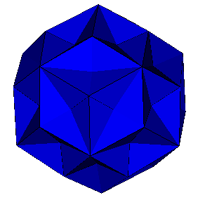 Excavated |
| Great
Ditrigonary Icosidodecahedron
(Dual) |
Degenerate see Great Icosahedron |
 Excavated (partially degenerate) |
Deltahedra from Deformed Duals of Trivalent Uniform Polyhedra
A number of the uniform polyhedra are tri-valent, i.e. they have three faces meeting at each vertex. If the platonic and Kepler-Poinsot polyhedra are excluded (as they are considered above), the remainder have duals with non-regular triangular faces. These duals can be deformed such that the faces become equilateral triangles. Face transitivity is retained in all cases. The 2 new deltahedra that result are included in the table below.
Notes:
* The deltahedra derived from the stellatruncated dodecahedron and icositruncated dodecadodecahedron duals are similar in appearance. They are distinct and have different nets. The distinction is best seen by following the above links to 'Vert', switching to 'frame' view and zooming on the centres of the polyhedra.
** The deltahedron derived from the great truncated icosahedron dual superficially resembles great icosahedron but each icosahedral face contains three coplanar triangles.
Credits
I am grateful to Mason Green for inspiring this page by suggesting that the list of isogonal deltahedra, consisting of the top three sections above plus the M°bius Deltahedra, may not be complete.
A number of the original dual figures were produced using Great Stella and relaxed using HEDRON.